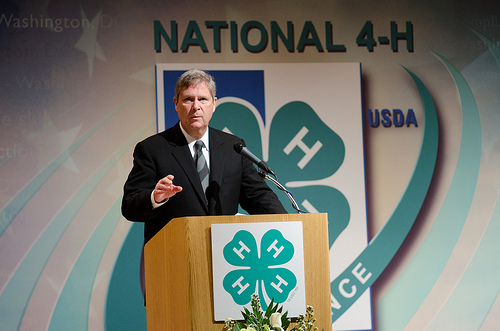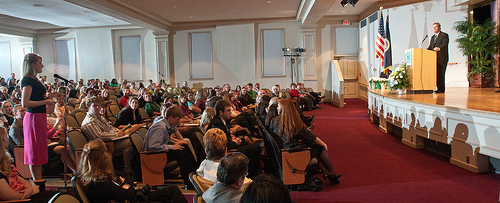Agriculture Secretary Vilsack Asks Gathering of 4-H Youth to Commit to Public Service, Reach Out to At-Risk Peers
“I pledge my Head to clearer thinking, my Heart to greater loyalty, my Hands to larger service and my Health to better living, for my club, my community, my country, and my world.” This is the pledge that 300 4-H youth and volunteers gave on Monday when the 2011 National 4-H Conference kicked off in Bethesda, Md. Youth and adults from 47 states and territories, as well a delegation from Canada, took part in an event that has happened in the Washington area since the 1920s, when 4-Hers slept in tents on the Washington Mall in front of the USDA headquarters. USDA’s National Institute of Food and Agriculture, or NIFA, is the parent organization to 4-H National Headquarters. Agriculture Secretary Tom Vilsack and Education Secretary Arne Duncan spoke to 4-Hers about community service, valuing education, and embracing positive health and nutrition habits.
 |
| U.S. Department of Agriculture (USDA) Secretary Tom Vilsack spoke with approximately 300 youth from 47 states or territories and Canada at the National 4-H Conference on Tuesday, April 5, 2011 in Washington, DC. The conference is the premier youth development opportunity of the USDA. Aged between 15-19 years old the attendees were selected by various means by their states to be delegates to the conference. The Secretaries then took questions from the audience. Secretary Vilsack received questions on topics such as land grants, what is an average day for him, and both talked of their goals to have 1,000 new farmers and 1,000 new educators. USDA photo by Lance Cheung. |
In one of the most moving parts of this remarks, Secretary Vilsack asked 4-H youth to reach out to their friends, family and peers in their communities if they are at risk of dropping out of school. He shared his personal story about when he answered the call to public service. It was the 1980s, he said, and he was working to help raise funds to build an athletic complex in his small Iowa town. The experience led him to join the city council, which led to his eventual election as mayor, Iowa State Senator, Governor of Iowa and, eventually, his appointment by President Obama to U.S. Secretary of Agriculture.
The Secretary asked the 4-Hers to use their pledge of head, heart, hands, and health to help guide them to success. The heart, said Vilsack, represents a commitment to the voice of youth, and he encouraged kids to hold a youth roundtable – register here – about issues that are important to them and their communities. Health, he said, represents a commitment to healthier living. 4-Hers are already taking steps towards better health through programs like the Presidential Active Lifestyle Award challenge. The Presidential Active Lifestyle Award recognizes those who log their recommended physical activity for six consecutive weeks, five days a week (60 minutes for kids, 30 minutes for adults).
 |
| Jessica Mullin (standing) asked U.S. Department of Agriculture (USDA) Secretary Tom Vilsack during the National 4-H Conference on Tuesday, April 5, 2011 in Washington, DC. Her question was how America will keep up with future demands. The conference is the premier youth development opportunity of the USDA. Aged between 15-19 years old the attendees were selected by various means by their states to be delegates to the conference. USDA photo by Lance Cheung. |
4-H initially committed to this goal during the November 29, 2010, roll-out of the Let’s Move! Faith and Communities Initiative led by First Lady Michelle Obama. Let’s Move! is the First Lady’s initiative to solve the challenge of childhood obesity within a generation. Let’s Move! Faith and Communities is designed to support local efforts and highlight accomplishments in communities across the country. The program looks to work with community leaders, learn from what they are doing in neighborhoods, and share those efforts as broadly as possible.
While at the conference, 4-H youth leaders will learn about mobilizing social change for issues that affect them, from bullying to environmental conservation, and will visit with federal officials where they will make presentations on these issues.
